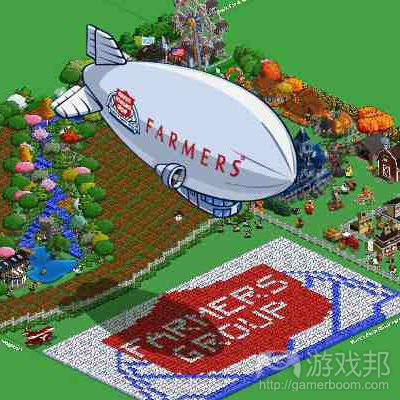社交游戏市场营销人员需知的四个问题
作者:Ryon Harms
你的亲人是否也会在每一刻的空闲时间登陆《Farmville》进行游戏?全世界共有超过2亿的玩家沉浸于诸如《Farmville》和《Millionaire City》等社交游戏中,孜孜不倦地在游戏中进行交换礼物,管理仓库等活动。可以说这类型游戏已经赶超了电子邮件,成为了世界上第二大盛行于网络中的活动。比起电子邮件,用户在社交游戏中投入了更多时间,那么如何才能让你的品牌也收获同样多的用户呢?
不要被社交游戏中可爱,亲切的卡通形象所欺骗。社交游戏是一个发展迅速的产业,预计到2013年将达到60多亿美元的营收。在美国,有超过20%的人口在玩社交游戏,而这些游戏玩家也不再是那些受妈妈约束的13岁男孩了。
如今,那些家庭主妇(妈妈)们都成为了社交游戏的常客。如果你想要更快且更有效地吸引到这些妈妈级用户,那就必须先正视这些虚拟农场,不要只把它们当成用于消遣的道具。
游戏为何具有社交性?
可以说社交游戏是社交网络发展的产物。社交网络能够推动朋友之间的进一步交流,而优秀的社交游戏则能够帮助朋友们建立或加深他们之间的友谊。玩家在现实世界中的社交共鸣可以说是社交游戏区别于其它大型多人游戏和单人游戏的关键因素。社交游戏的最大优点便是,它既能够为玩家提供一种共同娱乐的游戏空间,也能为玩家创造出一种有意义的社交互动行为。
谁最有时间玩社交游戏?
如果我说社交游戏玩家的平均年龄是48岁,那你一定会觉得我在开玩笑吧。很多研究表明,这些40岁左右(平均年龄)的玩家将有可能成为你们的目标用户群体。40多岁的玩家在所有社交游戏用户中占有相当大的比例,特别是在过去三个月中,这些玩家的数量更是明显增长。这些40多岁玩家会为了抽出时间玩社交游戏,而减少看书,看杂志,甚至是看电视和看电影的时间。也许你会认为一名50多岁的中老年人独自待在家里玩游戏是件很悲哀的事,但社交游戏实际上也可以是一项有意义的社交活动。
如何借此展开市场营销活动?
游戏开发商不会让市场营销活动破坏了玩家的游戏乐趣。虽然作为市场营销者,你必须知道提高用户对品牌的兴趣非常重要,但是如果因此必须让游戏体验进行妥协,那最终也是得不偿失,不利于品牌的健康发展。所以为了节省时间,并让游戏开发商接受你的市场营销方案,你必须考虑到三个关键点:
找到与品牌相契合的游戏。如果你的目标用户群体是女性,那么千万不要在《黑帮战争》这类游戏中展开市场营销活动。而如果你们的产品主要是针对厨房或饭店用具,那么《咖啡世界》便是一个很不错的选择。
对游戏有更深层次的认识。在刚开始的几周里,你应该亲自尝试一款游戏,并询问周遭朋友为何喜欢这款游戏等,这样才能让你更好地揣摩玩家们的想法。同时你还应该知道玩家能够从游戏中得到什么价值?你应该如何针对玩家的需求,更好地发挥游戏的这些价值,以推动品牌发展。
如何为品牌创造价值?
像Greg Thompson这些大有成就的游戏开发者会告诉你,“游戏只是一种发动工具,只能够推动你获得并挽留住更多用户。而真正能让你赚钱的则是那些具有创造性的商品。”这个道理也同样适用于游戏的市场营销活动。在游戏中用于购买创造性商品的货币叫做“虚拟货币”。玩家可以用现实货币去购买所需的虚拟货币,这种虚拟货币市场也正在飞速向前发展。虽然这个市场出现仅短短几年的时间,但预计到2013年,其市场规模将达60亿美元。
铁杆玩家愿意用现实货币兑换虚拟货币,甚至愿意花上20美元购买《Farmville》中的一辆虚拟拖拉机,有时候也会将自己购得的虚拟商品作为礼物赠送给其他玩家。所以对于市场营销者来说,与这些享有较大利润空间的游戏开发商合作是一个绝佳的机会,他们可通过为终端用户提供大量有价值的虚拟商品而获利。
在社交游戏中,绝大多数玩家都会欢迎的一种元素(无论它是否具有社交性)就是游戏“善意的欺骗”。这种“善意的欺骗”并没有改变游戏的基本原理,而只是稍作调整使游戏更加简单,且更有利于玩家舒缓压力。根据ISG调查,有45%的用户正是因为游戏具有舒缓压力的功能才着迷于游戏,但是极具讽刺的是,当你觉得游戏能够舒缓压力的同时,你在体验游戏过程中也正在感受着另一种压力。
所以,作为一名市场营销者,如果你想让品牌更具有市场竞争力,那就需要提供一些有益或者说具有“善意欺骗”元素的游戏,缓解他们在现实生活中的压力。(本文为游戏邦/gamerboom.com编译,如需转载请联系:游戏邦)
What’s Next: Social Game Marketing
by Ryon Harms on December 20, 2010
Does somebody you love waste every spare moment on FarmVille? Your loved one isn’t playing alone. More than 200 million people around the world spend countless hours exchanging gifts and raising barns together in simple yet addicting social games like FarmVille and Millionaire City. These games have proven to be so immersive that social gaming recently surpassed email as the second most popular activity on the web. So if consumers are spending more time on social games than on email, why aren’t brands doing the same?
Don’t let the cute and approachable avatars in social games fool you. Social gaming is a booming industry that’s expected to generate in excess of $6 billion by 2013. More than 20 percent of the U.S. population is playing social games, but they’re not your stereotypical 13-year old boys wearing out their controller thumbs in Mom’s basement.
It turns out the most committed player of social games is also the king maker when it comes to key purchases for the home and family – Mom. If want to reach Mom in an uncluttered marketing environment where she’s deeply committed and highly engaged, you might not consider those virtual farms such a waste of time after all.
What Makes a Game Social?
Social gaming is the natural progression from social networking. While social networking brings friends together, the best social games are the ones that help those friends create and build deeper relationships. What separates social games from other multi-player games and the single-player gaming set is the real world social resonance of their activities. At their best, social games hold the promise of allowing us to have a little fun together while simultaneously creating meaning.
Who Has Time for Social Games?
What if I told you that the average age of a social gamer is… 48? Several studies have shown that the average social gamer might actually be your target demographic. And among these 40-year-olds, 90% reported the same or increased game play over the last three months. Where are they finding the time? Well, they’re spending less time reading books and magazines and even less time watching TV or going to the movies. The image of a 50 year-old sitting at home playing games “alone” might sound sad to some, but in reality social games might actually be the more socially astute activity.
Planning Social Game Marketing
Game developers won’t let you mess with their franchise games enough to disrupt the fun. Your goal will be to push the interests of your brand, but with a keen understanding that changing the game in a way that suspends disbelief in game play will have a negative impact on your brand. To save yourself some time and disappointment from getting turned down by a developer for an in-game promotion, you should consider these three points:
Find a game that best represents your brand. If you’re an association for the advancement of women, don’t start a campaign on Mafia Wars. If you make products for kitchens or restaurants, then Cafe World might be a fantastic option.
Have a deep understanding of the game itself. Start an account, get into it for a few weeks and ask your friends that play the game why they love it so much.
Understand the gamers mentality. Where are they deriving value from the game? How can you add a little steroids to that value to make your brand the hero?
How to Deliver Value
As great game developers like Greg Thompson will tell you, “The game is just the engine to acquire and retain users, the money is made from the creative goods.” The same holds true for marketing.
The currency used to purchase creative goods in games is called Virtual Currency. Virtual currency is purchased with real world currency and it’s a market with unbelievable growth. Starting just a few years ago, it is expected to be a $6 billion dollar industry by 2013.
Players are so committed to their games that they’re willing to exchange real money for virtual currency used to purchase items like a $20 tractor in FarmVille. Players make these purchases to make their own game lives easier and sometimes they give them away to friends as gifts. Marketers have a very attractive opportunity to work with game developers, who enjoy immense profit margins, to purchase creative digital items in bulk that have a high perceived value to the end user.
If there’s one thing most gamers love, social or not, it’s what I call little white cheats. Little white cheats don’t change the long-term fundamentals of the game. They are short cuts that make life slightly easier and give the player some immediate relief from the pressures of the game. Stress relief is actually why 45% of social gamers play (according to a recent study by ISG), which is ironic when you consider that playing social games can actually be quite stressful as you try to keep up with the pressures of game play.
As a marketer, your job should be to figure out ways to position your brand as the hero by providing these harmless, but sought after little white cheats that lighten the stress load- something that can’t be done so easily in real life.(source:thesocialexec)
上一篇:综观社交游戏的品牌植入活动








































 闽公网安备35020302001549号
闽公网安备35020302001549号